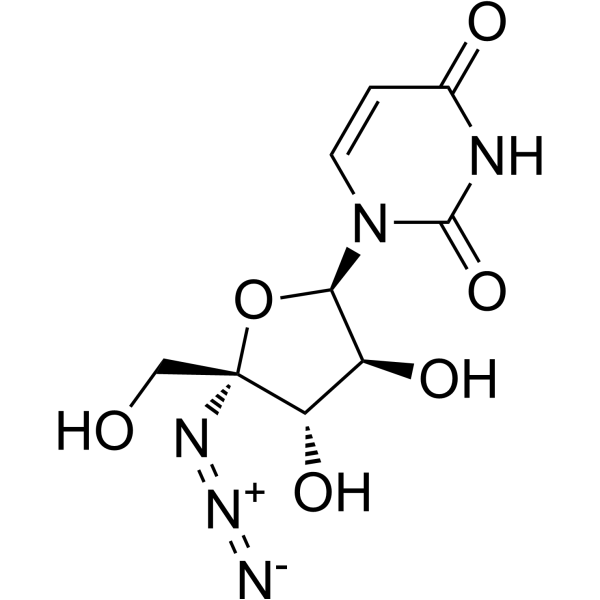Physicochemical Properties
| Molecular Formula | C9H11N5O6 |
| Molecular Weight | 285.213541269302 |
| Exact Mass | 285.07 |
| CAS # | 876708-01-9 |
| PubChem CID | 25185460 |
| Appearance | Light brown to gray solid powder |
| LogP | -1.5 |
| Hydrogen Bond Donor Count | 4 |
| Hydrogen Bond Acceptor Count | 8 |
| Rotatable Bond Count | 3 |
| Heavy Atom Count | 20 |
| Complexity | 517 |
| Defined Atom Stereocenter Count | 4 |
| SMILES | N([C@]1([C@@H](O)[C@H](O)[C@H](N2C=CC(=O)NC2=O)O1)CO)=[N+]=[N-] |
| InChi Key | FHPJZSIIXUQGQE-XZMZPDFPSA-N |
| InChi Code | InChI=1S/C9H11N5O6/c10-13-12-9(3-15)6(18)5(17)7(20-9)14-2-1-4(16)11-8(14)19/h1-2,5-7,15,17-18H,3H2,(H,11,16,19)/t5-,6-,7+,9+/m0/s1 |
| Chemical Name | 1-[(2R,3S,4S,5R)-5-azido-3,4-dihydroxy-5-(hydroxymethyl)oxolan-2-yl]pyrimidine-2,4-dione |
| HS Tariff Code | 2934.99.9001 |
| Storage |
Powder-20°C 3 years 4°C 2 years In solvent -80°C 6 months -20°C 1 month |
| Shipping Condition | Room temperature (This product is stable at ambient temperature for a few days during ordinary shipping and time spent in Customs) |
Biological Activity
| ln Vitro | In order to prevent the replication of the Hepatitis C virus (HCV), Nucleoside-Analog-2 is a 4'-Azidocytidine analogue. Citation for substance 12[1]. |
| References |
[1]. The design, synthesis, and antiviral activity of 4'-azidocytidine analogues against hepatitis C virus replication: the discovery of 4'-azidoarabinocytidine. J Med Chem. 2009 Jan 8;52(1):219-23. |
Solubility Data
| Solubility (In Vitro) |
DMSO : 33.33 mg/mL (116.86 mM) H2O : 20 mg/mL (70.12 mM) |
| Solubility (In Vivo) |
Solubility in Formulation 1: 2.5 mg/mL (8.77 mM) in 10% DMSO + 40% PEG300 + 5% Tween80 + 45% Saline (add these co-solvents sequentially from left to right, and one by one), clear solution; with sonication. For example, if 1 mL of working solution is to be prepared, you can add 100 μL of 25.0 mg/mL clear DMSO stock solution to 400 μL PEG300 and mix evenly; then add 50 μL Tween-80 to the above solution and mix evenly; then add 450 μL normal saline to adjust the volume to 1 mL. Preparation of saline: Dissolve 0.9 g of sodium chloride in 100 mL ddH₂ O to obtain a clear solution. Solubility in Formulation 2: 2.5 mg/mL (8.77 mM) in 10% DMSO + 90% (20% SBE-β-CD in Saline) (add these co-solvents sequentially from left to right, and one by one), clear solution; with ultrasonication. For example, if 1 mL of working solution is to be prepared, you can add 100 μL of 25.0 mg/mL clear DMSO stock solution to 900 μL of 20% SBE-β-CD physiological saline solution and mix evenly. Preparation of 20% SBE-β-CD in Saline (4°C,1 week): Dissolve 2 g SBE-β-CD in 10 mL saline to obtain a clear solution. Solubility in Formulation 3: 2.5 mg/mL (8.77 mM) in 10% DMSO + 90% Corn Oil (add these co-solvents sequentially from left to right, and one by one), clear solution; with ultrasonication. For example, if 1 mL of working solution is to be prepared, you can add 100 μL of 25.0 mg/mL clear DMSO stock solution to 900 μL of corn oil and mix evenly. Solubility in Formulation 4: 16.67 mg/mL (58.45 mM) in PBS (add these co-solvents sequentially from left to right, and one by one), clear solution; with ultrasonication (<60°C). (Please use freshly prepared in vivo formulations for optimal results.) |
| Preparing Stock Solutions | 1 mg | 5 mg | 10 mg | |
| 1 mM | 3.5062 mL | 17.5309 mL | 35.0619 mL | |
| 5 mM | 0.7012 mL | 3.5062 mL | 7.0124 mL | |
| 10 mM | 0.3506 mL | 1.7531 mL | 3.5062 mL |
